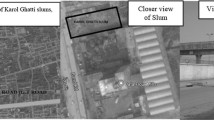Abstract
Slums in India are characterized by unhygienic living conditions like filthy streets, cramped houses, insufficient light and ventilation and poor services. Apart from this their lies an organic solution of housing brought by democratic will of the dwellers within. Though not created by architects or planners, they are housing by the people responding to their specific needs. The concern of this paper is to bring out those specific features, which should be retained while working on betterment of slums. Government’s answer to this issue has always been addressed in various programs under housing needs. Since early 70s till today, there have been schemes like Environmental Improvement of Urban Slum scheme (1972), Sites and services scheme(1980), Urban basic services for the poor(1985), The night Shelter Scheme for Pavement dwellers (1990), National Slum Development Programme (1997), Valmiki Ambedkar Awas Yojana (2001), National Slum Development Programme (2006), Rajiv Awas Yojana (2013), Pradhan Mantri Awas Yojana (2015) etc. Whether to relocate and rehabilitate them, or redevelop and give them better-living conditions in the same location, government has constantly been struggling with various appropriate alternatives for finding solutions to these issues. But still one struggles to find a successful slum improvement program or project that can be studied and its approaches or principles can be adopted while finding solutions to similar issues. It is obvious that there cannot be a one size fits all solution to deal with such an issue. The specific needs and links have to be addressed in solutions provided for betterment of these slums. The intent of the paper is to understand the characteristics of the built fabric of an informal settlement by adopting the framework of Ian Bentley in the book, Responsive Environments, which is an outcome of concerns over the loss of human considerations in the modern urban environment. The methodology adopted for this paper relies on primary survey of the slum through visual observations, personal interviews and detailed documentation of one “Vaas.” The case taken in this paper is of an informal settlement, which lies in a central location of Ahmedabad named Hollywood Basti in Gulbai Tekra. It is well known for sculpting using Plaster of Paris and has a good hold on market at local and national level. This settlement lies in a high development potential zone as it is surrounded by mixed use landuse and falls under Transit oriented Development zone as per Ahmedabad Development Plan. The settlement has gradually evolved from a small group of people native of Rajasthan, who migrated and settled here since 1856 and have blended well with the Gujarati culture over time. This paper brings forth various aspects under permeability, variety, legibility, robustness, richness and personalization that need to be considered and retained while undertaking any initiatives for upgradation or rehabilitation of these informal settlements.
Access this chapter
Tax calculation will be finalised at checkout
Purchases are for personal use only
Similar content being viewed by others
References
Bentley, I. (1985). Responsive environments. Burlington: Elsevier Ltd.
Jacobs, J. (1961). The death and life of Great American Cities.
Khanna, K. (2012, May). Going Hollywood. Retrieved from www.betterphotography.in: http://www.betterphotography.in/features/hollywood/12661/.
Kitto, H. (1996). The Polis. The City Reader.
Lynch, K. (1960). Image of the city. MIT Press.
Merriam Webster. (n.d.). Definition of permeability. Retrieved from www.merriam-webster.com: https://www.merriam-webster.com/dictionary/permeability.
Mumford, L. (1937). What is a city. Architectural Record.
Patel, N. (2007). Understanding & analysing the dynamics of an urban slum & complexity of its rehabitation: A study of Gulbai Tekra & Odhav, Ahmedabad. Ahmedabad.
Shrivastava, M. (2019, July 28). Idolising Nomadic Life. Retrieved from www.deccanherald.com: https://www.deccanherald.com/sunday-herald/sunday-herald-melange/idolising-nomadic-life-749740.html.
Author information
Authors and Affiliations
Corresponding author
Editor information
Editors and Affiliations
Rights and permissions
Copyright information
© 2021 The Author(s), under exclusive license to Springer Nature Singapore Pte Ltd.
About this paper
Cite this paper
Mehta, D., Madhavi, P., Kabaria, Y. (2021). Informal Settlement as a Self-sufficient Responsive Neighborhood: A Case of Hollywood Basti—Gulbai Tekra, Ahmedabad. In: Jana, A., Banerji, P. (eds) Urban Science and Engineering. Lecture Notes in Civil Engineering, vol 121. Springer, Singapore. https://doi.org/10.1007/978-981-33-4114-2_8
Download citation
DOI: https://doi.org/10.1007/978-981-33-4114-2_8
Published:
Publisher Name: Springer, Singapore
Print ISBN: 978-981-33-4113-5
Online ISBN: 978-981-33-4114-2
eBook Packages: EngineeringEngineering (R0)




